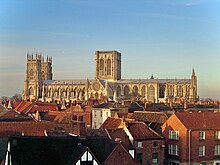
Back كاتدرائية يورك Arabic كاتدرائية يورك ARZ Ёркскі сабор Byelorussian Йоркска катедрала Bulgarian Yorská katedrála Czech York Minster Danish York Minster German Katedralo de Jorko Esperanto Catedral de York Spanish Yorkeko katedrala Basque
| York Minster | |
|---|---|
| Cathedral and Metropolitical Church of Saint Peter in York | |
 The southern façade of the cathedral, including the rose window on the south transept. | |
| 53°57′43″N 1°4′55″W / 53.96194°N 1.08194°W | |
| OS grid reference | SE 603 522 |
| Location | Deangate, York[1] |
| Country | England |
| Denomination | Church of England |
| Previous denomination | Roman Catholic |
| Churchmanship | Anglo-Catholic[2][1] |
| Website | yorkminster |
| History | |
| Status | Cathedral |
| Founded | 627 |
| Dedication | Saint Peter |
| Consecrated | 3 July 1472 |
| Associated people | William of York |
| Architecture | |
| Functional status | Active |
| Heritage designation | Grade I |
| Designated | 14 June 1954[3] |
| Previous cathedrals | at least 3 |
| Architectural type | Cathedral |
| Style | Early English, Perpendicular |
| Years built | c. 1230–1472 |
| Groundbreaking | 673 |
| Completed | 1472 |
| Specifications | |
| Length | 524.5 feet (159.9 m)[4] |
| Nave length | 262 feet (80 m)[5] |
| Width | 222 feet (68 m)[4] |
| Nave width | 98 feet (30 m)[5] |
| Nave height | 99 feet (30 m)[4] |
| Choir height | 102 feet (31 m)[5] |
| Number of towers | 3 |
| Tower height | Central Tower: 235 feet (72 m)[4] Western Towers: 196 feet (60 m)[4] |
| Bells | 36 |
| Administration | |
| Province | York |
| Diocese | York (since 314) |
| Clergy | |
| Archbishop | Stephen Cottrell |
| Dean | Dominic Barrington |
| Precentor | James Milne |
| Canon(s) | 1 vacancy |
| Canon Pastor | Timothy Goode |
| Canon Missioner | Maggie McLean |
| Archdeacon | Samantha Rushton |
| Laity | |
| Director of music | Robert Sharpe |
| Business manager | David Colthup (Chapter Steward) |
 | |
| Official name | York Minster cathedral precinct |
| Designated | 8 October 1937 |
| Reference no. | 1017777 |
Listed Building – Grade I | |
| Official name | Cathedral Church of St Peter, York Minster |
| Designated | 14 June 1954 |
| Reference no. | 1257222 |
York Minster, formally the Cathedral and Metropolitical Church of Saint Peter in York, is an Anglican cathedral in the city of York, North Yorkshire, England. The minster is the seat of the archbishop of York, the second-highest office of the Church of England, and is the mother church for the diocese of York and the province of York.[6] The Church is often described as part of the Anglo-Catholic tradition.[7]It is administered by its dean and chapter. The minster is a Grade I listed building and a scheduled monument.
The first record of a church on the site dates to 627; the title "minster" also dates to the Anglo-Saxon period, originally denoting a missionary teaching church and now an honorific.[8] The minster undercroft contains re-used fabric of c. 1160, but the bulk of the building was constructed between 1220 and 1472. It consists of Early English Gothic north and south transepts, a Decorated Gothic nave and chapter house, and a Perpendicular Gothic eastern arm and central tower.
The minster retains most of its medieval stained glass, a significant survival among European churches.[9] The east window, which depicts the Last Judgment, is the largest expanse of medieval stained glass in the world. The north transept contains the Five Sisters window, which consists of five lancets, each over 53 feet (16.3 m) high, filled with grisaille glass.[10]
- ^ "York Minster". York Minster. Retrieved 22 August 2020.
- ^ "York Minster". Screen Yorkshire. Retrieved 14 January 2025.
- ^ Historic England. "Cathedral Church of St Peter, York Minster (1257222)". National Heritage List for England. Retrieved 22 June 2016.
- ^ a b c d e Bigland, John (1815). Yorkshire; or, Original Delineations, Topographical, Historical, and Descriptive of That County. London. p. 211. OCLC 19912009. Retrieved 14 September 2016.
- ^ a b c "York Minster". York Minster. Retrieved 20 January 2022.
- ^ "York Minster a Medieval Cathedral" (PDF). Archived from the original (PDF) on 8 February 2017. Retrieved 11 July 2017.
- ^ "York Minster". Screen Yorkshire. Retrieved 20 January 2025.
- ^ "York Minster FAQs". York Minster. Archived from the original on 16 November 2007. Retrieved 1 January 2010.
- ^ Pesvner, Nikolaus; Metcalf, Priscilla (2005). The Cathedrals of England: The North and East Anglia. London: The Folio Society. pp. 294–95, 303.
- ^ "Work Minster Fact Sheets: The Five Sisters Window" (PDF). Archived from the original (PDF) on 15 November 2017. Retrieved 27 February 2018.
